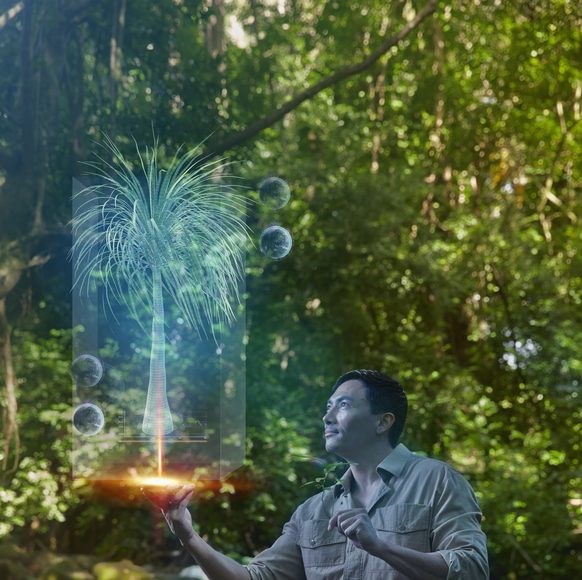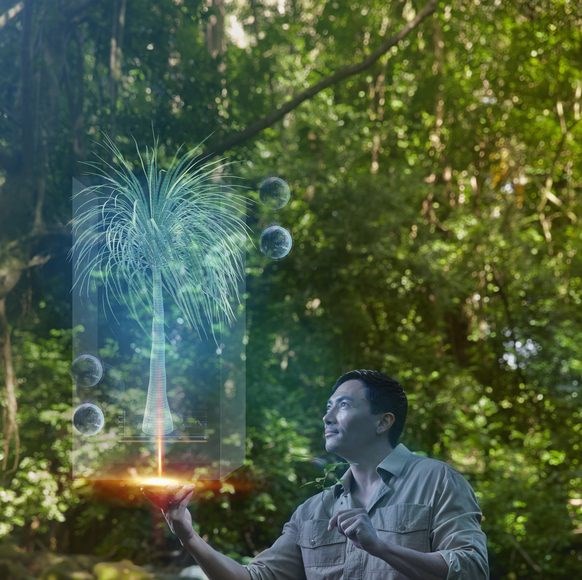 Reality or fiction? The new entertainment of virtual reality is challenging our perceptions about what is real or imaginary. For example, a popular viral video is making its way around social media recently depicts a humpback whale leaping dramatically up through a gym floor, where scores of children stand watching and gasping enthusiastically as it makes a huge splash when it comes back down and hits the floor, which becomes the ocean. Reality? Of course not!
Reality or fiction? The new entertainment of virtual reality is challenging our perceptions about what is real or imaginary. For example, a popular viral video is making its way around social media recently depicts a humpback whale leaping dramatically up through a gym floor, where scores of children stand watching and gasping enthusiastically as it makes a huge splash when it comes back down and hits the floor, which becomes the ocean. Reality? Of course not!
Magic Leap, a new company that is making its own waves within the virtual reality industry, created this dramatic image. Commenting on the video, the tech division of media site Newsie explains that the technology is a “dynamic digitalized light field signal” which merges lifelike, computer generated images – like the whale – with what the user sees in the real world. It’s called "Augmented Reality". It involves a wearable projector that tracks the users eyes – like Google glass, but actually works like it’s supposed to.
Entertaining, fascinating, and an escape from our boring everyday lives, virtual reality is the next enthralling invention to engage us. Moving on from the magic shows of yesterday’s traditional illusionists, we now have the opportunity to experience the hologram deck from Star Trek – Next Generation in our living rooms. Anyone who saw the video of a 90-year old woman having her first experience with the Oculus Rift technology understands the thrill. “If I try to explain this to anybody, they won’t believe me,” she gasped, adding, “I don't believe I am seeing this.”
But what these modern illusionists show us is that seeing should not necessarily be believing.
In his TedTalk, Do we see reality as it is? Dr. Donald Hoffman, a cognitive scientist used the simple examples of how people in the past viewed the earth as flat and as the unmoving centre of the universe to illustrate how we can be fooled. But that’s how it looks – even now. Both these perceptions were proven wrong, long ago. In the 16th century, when challenging the prevailing belief that the earth was flat, Galileo wondered how many other things we see and misinterpret. According to Hoffman, Galileo mused, “I think that tastes, colors, odors and so on reside in consciousness.”
Why is this important to us? Because, if we only believe what we are seeing from the material standpoint, then we can be misled and limited in our lives.
Less dramatic but more insidious in our thinking, is how we often see difficult circumstances in our lives as barriers to health and happiness. “If only this or that problem would go away then I could be happy,” is a common thought that suggests such a barrier. It could be financial worries, an unhappy work experience or relationship, a job promotion that did not materialize, or fears regarding our health – or maybe all of those together.
If we stop at these perceived problems or limitations, allowing our view of them to permanently shape our experience, then we fail to see through them to the answers we need, and we remain stuck. But we don’t need to do that. There are many inspiring examples of individuals who have shown us how to view things differently and create different outcomes.
Steve Jobs, famous in his own right for seeing new ways to forward the technology that reframes how we see the world, once wrote a now famous commercial called - Here’s to the crazy ones. The video honours individuals who looked beyond the accepted limitations and opinions of our one-dimensional viewpoints to discover new ones, consequently changing how we see our neighbour, the world, and even the universe. His examples included Gandhi, Einstein, Martin Luther King, among others, all of whom challenged the accepted social, scientific, and spiritual views of their day. They didn’t see barriers – they saw opportunities. And they never gave up moving forward.
By including Dr. Martin Luther King in his now famous video, Jobs touches on something spiritual. Some of the greatest examples of individuals who see beyond the perceived barriers of the human mind have been spiritual thinkers. For example, Jesus well understood the relationship between consciousness and what we experience. But he understood real consciousness as having its source in the Divine, rather than in the human brain. He saw the world, not through virtual reality glasses with fancy names, but instead through a perception of man and creation as spiritual.
When his divine vision of reality was brought to bear on human thinking, people experienced healing from all kinds of problems – illness, lack, and fear. Jesus changed the perceptions of how people saw themselves and others, and the world around them, showing them a different reality – a divine creation.
One example that I find gives food for thought is the story of Jesus and the loaves and fishes. It is the only story about Jesus that is recounted in all four gospels of The Bible. A multitude of people who had been listening to his teachings were hungry and needing to be fed. His followers found just a few loaves and fishes – definitely not enough to feed everyone. Jesus’s prayer of gratitude changed the human perception of that situation so completely that all were fed, and there were even leftovers.
Impossible? Think about what Galileo said about consciousness, or the way Einstein changed the way we see the universe. What might we each be able to achieve if we are willing to see things differently – health, prosperity, peace?

Anna Bowness-Park is a Christian Science practitioner, who writes frequently on the relationship between consciousness and health, and how prayer can play a role. You can follow her blog at http://anna-bownesspark.ca
You can read more articles on our interfaith blog, The Spiritual View, HERE


